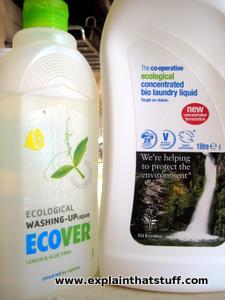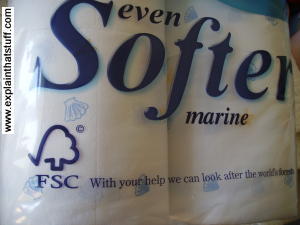
Eco labeling
by Chris Woodford. Last updated: December 2, 2022.
Which one should I buy? That's the question that probably buzzes through your head every few seconds as you trail through the grocery store. Lots of people like to shop with at least one eye on the planet, though ethical shopping isn't easy. Many products seem to be "natural" or "eco-friendly"—they might have labels covered in flowers, fields, animals, or trees—without offering any real evidence to back up their claims. How, then, can you quickly and reliably figure out that one product is better for the planet than another? The solution is to look out for eco-labels—recognizable, reputable symbols that guarantee a basic level of environmental friendliness. What are eco-labels and how do they work? Let's take a closer look!
Photo: Two bottles of eco-friendly washing detergent. Note the use of natural imagery (flowers and leaves on the left; a waterfall on the right). The bottle on the right carries the EU Eco Label—an objective guarantee of its environmental credentials.
Sponsored links
Contents
What are eco-labels?
An eco label is a trustworthy symbol that manufacturers can put on the things they sell to demonstrate that they are genuinely better for the environment than comparable products.
Most eco labels are voluntary: canned fish producers might apply for permission to use a label from the Marine Stewardship Council (MSC) showing that the salmon they catch meets its standards of sustainability, while timber producers might ask for certification by the Forest Stewardship Council (FSC) to prove that their wood hasn't come from a tropical rainforest. Other eco labels are mandatory: for example, in North America, manufacturers of cars and major household appliances are obliged to label their products to show how energy efficient they are; in Europe, makers of major electrical appliances also have to display a label containing an A–G rating (A is good, G is bad) showing its level of energy efficiency.

Photo: The FSC logo helps you to spot wood and paper products that come from "well-managed, sustainable forests"; choosing products marked this way means you're not contributing to damage in threatened areas such as tropical rainforests.
There are many different eco-labeling schemes in operation around the world, each covering a different range of environmental criteria. Some labels are very narrowly defined: for example, a label that reads "100% recycled" tells you only that a product has been made from recycled materials; it doesn't guarantee the factory where the product was made produced no air pollution, used no child labor, paid its workers fairly, or didn't transport its goods by environmentally damaging air freight. Other labels seem narrowly defined but implicitly include broader standards of environmental performance. For instance, if you buy organic food in the UK that's certified by a body called the Soil Association, you're guaranteed not just that the food was grown without pesticides but also that any animals involved in its production were treated humanely. Some labels, including the EU Eco Label, certify good environmental performance across a much wider range of criteria, including the use of raw materials and energy, the degree of recycling and reuse, whether air, water, or land pollution was produced during manufacturing, and so on.
For eco-labeling to work, it's essential that labels appear only on products that meet the standards they advertise. In practice, that means product manufacturers have to apply to some independent certification authority for a licence to display a label, which is granted only if their product meets specific criteria. Often, manufacturers have to pay a fee to cover the cost of administering the scheme and are granted permission to use a label under the terms of a legally binding contract.

Photo: Fish stocks are dwindling in many of the world's seas. The MSC logo is meant to help you find fish from well-managed, sustainable sources, which means threatened stocks get a chance to recover. Even big, well-known labels like this have their critics.
Advantages and disadvantages of ecolabeling
Ecolabels offer three major benefits. First, for consumers, they're a shortcut to doing good: they're an easy-to-use, trustworthy guide to products that help the environment in some way. If you're racing up and down your supermarket, quickly trying to decide what to buy, looking out for products that carry an authoritative, recognizable symbol like the EU Ecolabel is a fairly dependable approach.

Photo: One of the world's most trustworthy and rigorous eco-labeling schemes, the European Union (EU) Ecolabel is partly designed to stimulate the market for eco-friendly goods.
Second, for manufacturers, ecolabels offer a potential point of difference and a competitive advantage. Many consumers take environmental performance into account so if a product looks eco-friendly and doesn't cost much more, it's more likely to be lifted off the shelf. For manufacturers, making eco-friendly products can make commercial sense.
Third, labels encourage a general raising of environmental performance, even among products that aren't labeled. According to the International Standards Organization (ISO), the body that guarantees worldwide uniformity in the way we measure things, the objective of ecolabels is:
"...through communication of verifiable and accurate information, that is not misleading, on environmental aspects of products and services, to encourage the demand for and supply of those products and services that cause less stress on the environment, thereby stimulating the potential for market-driven continuous environmental improvement."In simpler words, if environmentally friendly products sell better, all manufacturers have an incentive to produce them—and standards rise overall.
The biggest problem with a growing interest in ethical shopping is that manufacturers may be tempted to make exaggerated or misleading claims, which confuse consumers into thinking products are better than they really are. Instead of raising standards, the result is confusion among consumers and a systematic undermining of all eco-friendly products (including genuine ones). This, of course, is exactly the problem that properly certified ecolabels are designed to solve. For the system to work, eco-labels need to be trustworthy, trusted, simple to understand, and easy-to-recognize.

Chart: Which products are most likely to be registered for an EU Ecolabel? Just four types of products account for almost three quarters of all label registrations: indoor and outdoor paints and varnishes (41%), tissue paper and tissue products (17%), textiles (9%), and hard surface cleaning products (7%). Figures from EU Ecolabel Facts and Figures: September 2022.
The bottom line
Trust genuine ecolabels, but try to make sure you understand what they mean. If you care enough to shop ethically in the first place, care just a bit more and ensure your money really is making the difference you want it to make. Do some research online. Find out where your products actually come from, how they're produced, and what steps manufacturers have taken to clean up their act. Don't automatically assume that unlabeled products aren't environmentally friendly. If you have time, try to make really informed decisions about what you buy by researching in helpful magazines and websites such as Ethical Consumer, The Good Shopping Guide, Mother Jones, and so on.



